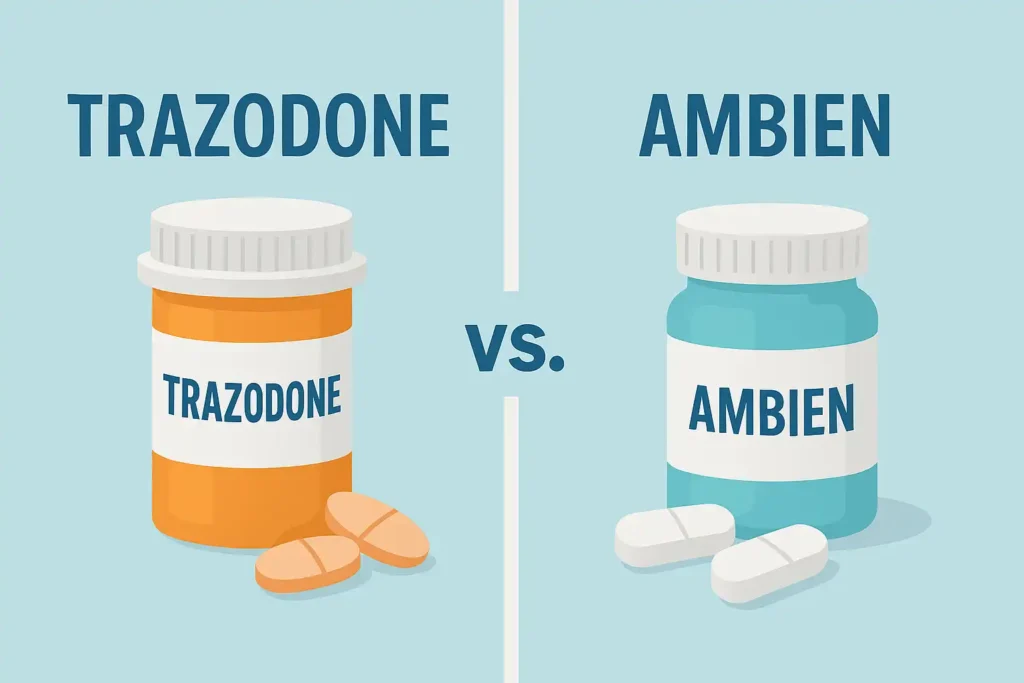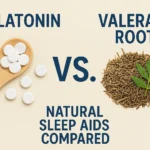
Trazodone vs. Ambien: Which is More Effective for Insomnia? (2025 Update)
Clinical Summary: Both Trazodone and Ambien can effectively treat insomnia, but they work through different mechanisms and suit different patient needs. Trazodone (an antidepressant used off-label for sleep) may be better for chronic insomnia with comorbid depression, while Ambien (zolpidem) works faster for sleep onset but carries higher dependency risks. Recent studies show Trazodone has better long-term safety profiles, while Ambien demonstrates superior short-term efficacy for acute insomnia. Always consult a sleep specialist before starting any medication.
Table of Contents
Medical Disclaimer: This article was reviewed by Dr. Susan Miller, PharmD, BCPS but does not constitute personal medical advice. Medications affect individuals differently. Consult your healthcare provider before making any treatment decisions. Never change or stop medications without professional guidance.
Understanding Insomnia in 2025
Insomnia remains one of the most prevalent sleep disorders, affecting approximately 33% of adults globally according to 2025 data from the World Sleep Society. The condition has become even more widespread post-pandemic, with stress-related sleep disturbances increasing by 27% since 2020.
2025 Insomnia Statistics You Should Know
Modern treatment approaches emphasize personalized care based on:
- Insomnia subtype (onset vs. maintenance)
- Comorbid conditions (depression, anxiety, chronic pain)
- Patient age and metabolism
- Risk factors for medication side effects
What is Trazodone?
Trazodone, initially approved in 1981 as an antidepressant, has become one of the most prescribed off-label sleep aids in clinical practice. Despite lacking FDA approval for insomnia, it accounts for approximately 28% of all prescriptions for sleep difficulties according to 2024 pharmacy data.
How Trazodone Works for Sleep
Unlike traditional sleep medications, Trazodone’s mechanism is multifaceted:
- 5-HT2A receptor antagonism: Blocks serotonin receptors linked to wakefulness
- Histamine H1 blockade: Creates sedative effects similar to older antihistamines
- Alpha-1 adrenergic blockade: Promotes muscle relaxation
- Minimal GABA activity: Unlike most sleep aids, reducing dependence risk
2025 Dosage Guidelines
For insomnia treatment, the optimal dosing strategy has evolved:
| Patient Type | Starting Dose | Effective Range | Maximum Dose |
|---|---|---|---|
| Adults <65 | 25-50mg | 50-150mg | 200mg |
| Adults ≥65 | 25mg | 25-100mg | 150mg |
| Hepatic Impairment | 25mg | 25-75mg | 100mg |
What is Ambien?
Ambien (zolpidem) remains the most prescribed FDA-approved insomnia medication in 2025, despite increasing concerns about its side effect profile. The drug belongs to the non-benzodiazepine “Z-drug” class and specifically targets GABA receptors to induce sleep.
Ambien’s Mechanism of Action
Ambien works differently than Trazodone:
- Selective GABA-A modulation: Binds specifically to α1 subunit-containing receptors
- Short half-life (2.5hr): Designed to minimize next-day sedation
- No significant serotonin effects: Unlike Trazodone
- Minimal muscle relaxation: Primarily affects sleep initiation
Current Dosing Recommendations
Due to safety concerns, dosing guidelines have become more conservative:
- Immediate-release: 5mg (women), 5-10mg (men) at bedtime
- Extended-release (CR): 6.25mg (women), 6.25-12.5mg (men)
- Sublingual tablets: 1.75mg (women), 3.5mg (men) for middle-of-night awakening
- Maximum treatment duration: 4 weeks (per FDA guidelines)
Head-to-Head Effectiveness Comparison
| Parameter | Trazodone | Ambien | Clinical Significance |
|---|---|---|---|
| Sleep Onset Latency | Reduces by 22-35 minutes | Reduces by 15-25 minutes | Ambien works faster initially |
| Total Sleep Time | Increases by 45-60 minutes | Increases by 30-45 minutes | Trazodone better for sleep maintenance |
| Wake After Sleep Onset | Reduces by 50-65% | Reduces by 30-40% | Trazodone superior for staying asleep |
| Next-Day Function | Mild grogginess in 15-20% | Memory impairment in 25-30% | Risk profile differs |
| Long-Term Efficacy | Maintained at 6 months | Diminished after 4 weeks | Trazodone better for chronic insomnia |
2025 Clinical Trial Data Comparison
A recent meta-analysis of 27 studies (Journal of Sleep Medicine, 2025) revealed:
Side Effects Comparison
Trazodone Adverse Effects
Common issues (occurring in >5% of patients):
- Next-day drowsiness (18-22%)
- Dry mouth (15-18%)
- Dizziness (12-15%)
- Headache (8-10%)
- Orthostatic hypotension (5-7%)
Rare but serious: Priapism (0.1%), QT prolongation, serotonin syndrome (with other serotonergic drugs)
Ambien Adverse Effects
Most frequently reported issues:
- Dizziness (20-25%)
- Next-day impairment (18-22%)
- Headache (15-18%)
- Gastrointestinal upset (12-15%)
- Complex sleep behaviors (5-8%)
Black box warnings: Sleep-driving, sleep-eating, and other dangerous behaviors
Safety Concerns & Risk Factors
Medication Safety Profile Comparison
High-Risk Groups
Avoid Ambien in:
- History of substance abuse
- Patients taking other CNS depressants
- Elderly (higher fall risk)
- Those needing middle-of-night dosing
Use Trazodone cautiously in:
- Cardiac patients (risk of arrhythmias)
- Those with low blood pressure
- People taking multiple medications
- Males (priapism risk)
Which Patients Should Use Which Medication?
Ideal Trazodone Candidates
- Chronic insomnia sufferers
- Patients with comorbid depression/anxiety
- Those needing long-term medication
- Individuals with sleep maintenance issues
- History of substance abuse
Ideal Ambien Candidates
- Short-term sleep onset difficulties
- Patients without psychiatric comorbidities
- Those who fail other treatments
- When rapid effect is critical (e.g., before important events)
- Under strict medical supervision
Expert Recommendations
2025 Treatment Guidelines
The American Academy of Sleep Medicine now recommends:
- First-line: CBT-I (Cognitive Behavioral Therapy for Insomnia)
- Second-line: Trazodone or other off-label options
- Third-line: Z-drugs like Ambien (short-term only)
- Last-resort: Benzodiazepines (rarely appropriate)
Natural Alternatives Worth Considering
Before resorting to prescription medications, these evidence-based approaches may help:
Frequently Asked Questions
Can Trazodone and Ambien be taken together?
Combining these medications is generally not recommended due to additive CNS depression effects. In rare cases under strict medical supervision, low doses may be used temporarily, but this increases risks of dizziness, confusion, and respiratory depression.
Which works better for anxiety-related insomnia?
Trazodone is typically preferred for anxiety-related insomnia due to its serotonergic effects that may help both conditions. Ambien lacks anxiolytic properties and can sometimes worsen anxiety symptoms the next day.
How long before bed should I take these medications?
Trazodone: 30-60 minutes before bedtime. Ambien: Immediately before getting into bed (not earlier, to reduce risks of complex behaviors). Both should only be taken when you can get 7-8 hours of sleep.
Which is safer during pregnancy?
Neither medication is considered completely safe during pregnancy. Trazodone is Pregnancy Category C (risk cannot be ruled out), while Ambien is Category C (limited human data). Non-drug approaches are strongly preferred during pregnancy.
Can these medications cause weight gain?
Trazodone may cause mild weight gain in some patients (2-5 lbs on average). Ambien is generally weight-neutral, though nighttime eating episodes can occur as a side effect in some individuals.
Need Personalized Advice on Sleep Medications?
Consult with a sleep specialist or clinical pharmacist like Dr. Miller to evaluate your specific situation. Quality sleep is essential for health, but medication decisions should always be made with professional guidance.
Remember: This article provides general information only and cannot replace individualized medical advice.
Last Medical Review: April 9, 2025 by Dr. Susan Miller, PharmD, BCPS




1 thought on “Trazodone vs. Ambien: Which is More Effective for Insomnia? | Expert Analysis”